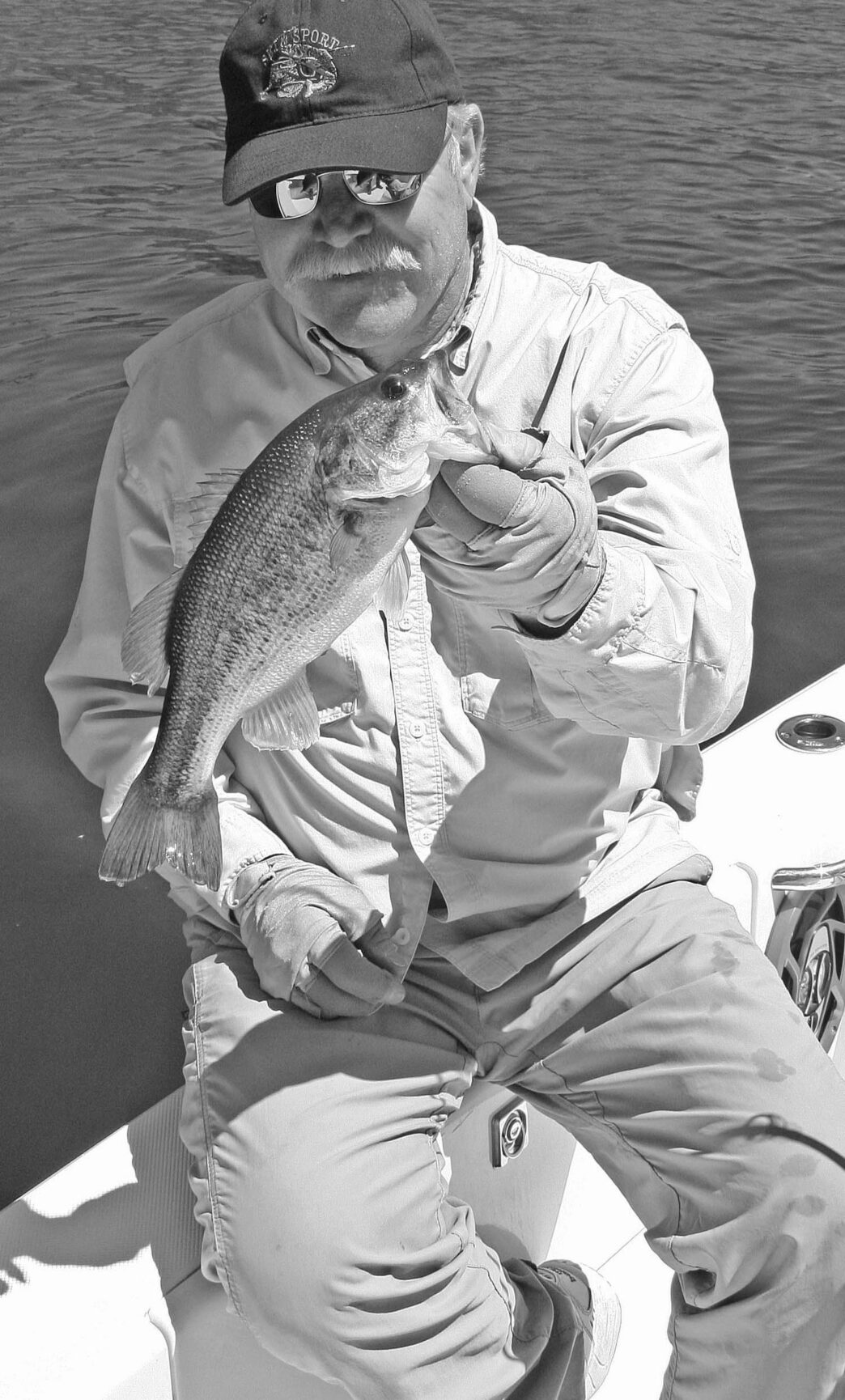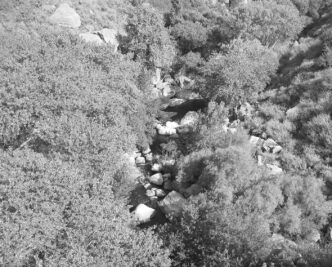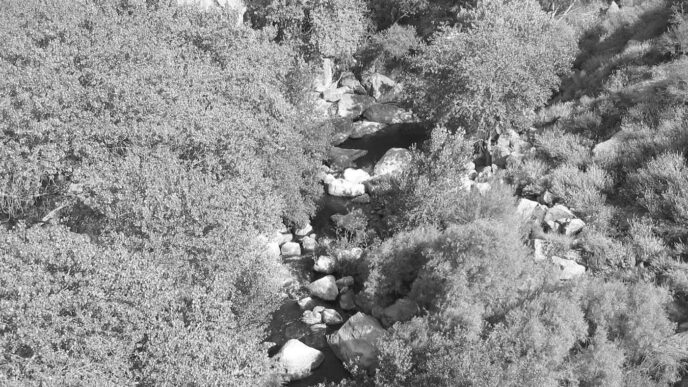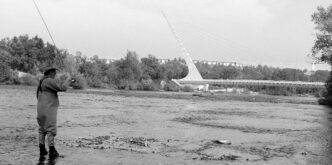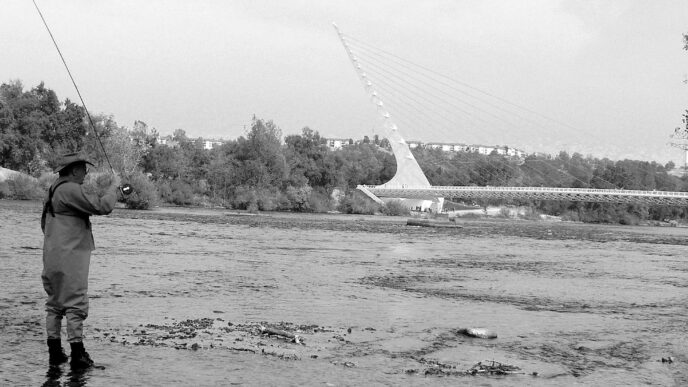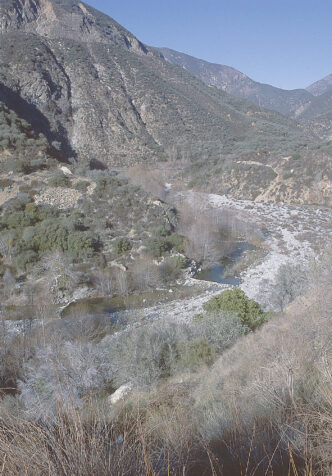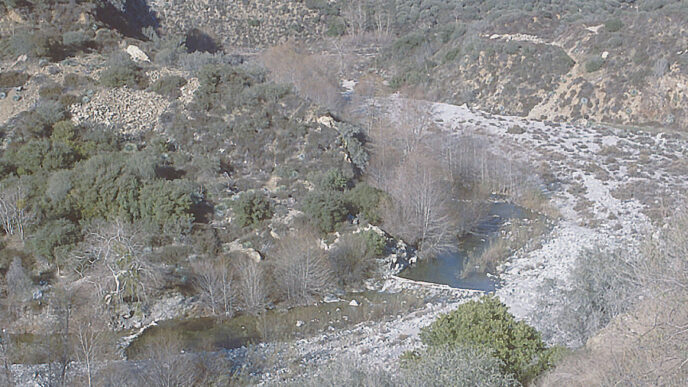“Windy enough for ya?” I almost couldn’t hear the question. The howling gale that swept across the water had blown my fly line straight out behind me like a flag in a hurricane. What had started as a nice spring day, with a few puffy clouds riding a brilliant blue sky and a shot at some of the fat trout and bass that swim in the waters of Silverwood Lake, had turned, as it so often does, into a situation where retreat to the car seemed the only choice. The guy who shouted the question stayed at it for a few more minutes, then exited to his vehicle in evident disgust.
Silverwood can be a great place to fish. I’ve been angling the lake since it was created in the early 1970s. While Silverwood is a State Recreation Area, it is also a California Water Project reservoir. At about a thousand acres, it is large enough and deep enough to host plenty of striped bass. It is cool enough year-round to support a really decent trout fishery, and it is also warm enough, and with enough shallow structure near shore, to have an equally good bass fishery. In other words, it’s a jack-of-all-trades sort of angling destination. That makes it, I think, an ideal stillwater fishery for the fly angler who would like the opportunity to catch a mixed bag of game fish on any given day.
But that wind is a problem at Silverwood. The impoundment is located near Cajon Pass, a sort of funnel that gathers onshore afternoon winds from the Los Angeles basin and the coast and shoves them through the pass into the high desert beyond Silverwood. Because Silverwood is located on the back side of the hills to the east of the pass, when the wind blows through the pass, it also sweeps down over the lake and quickly turns it into whitecaps. This doesn’t happen every day, but it is a good bet that it will happen four or five days out of a week. You do get occasional evenings when the wind dies just before sunset, and these times can offer outstanding fishing, but in the overall scheme of things at Silverwood, placid afternoons are rare.
This fact makes Silverwood a great morning fishery. The crack of dawn is not a moment too soon to hit the lake if you want the best conditions. The park has fairly liberal hours of operation, and it opens earlier and stays open longer in the summer. Plus, you can park outside the park and walk in to fish whenever you like, even during off hours.
Silverwood has had a number of interesting fish stocked in it during its lifetime. As in almost all Southern California waters, largemouth bass, bluegills, and crappies were the first additions, as were hatchery-raised trout intended to provide fish for anglers throughout the year.
Silver salmon were introduced, but failed to thrive. I talked to an angler who had fished the lake for many years, and he told me of catching fairly impressive silvers for a couple of years trolling with lead-core line. The California Department of Fish and Game also tried stocking brown trout, and that fishery was more successful. I was beginning to fly fish for bass at about the time Silverwood filled, and I would go there to cast flies for bluegills and small bass. At lunchtime, I would drive around to the marina and marveled at the chunky brown trout — often well over five pounds — that trollers would bring to display and weigh at the scales. I never managed to catch one of these big browns while they existed in Silverwood, probably because at that time I was strictly a wading angler and never reached deep enough water with my flies.
Now, unfortunately, neither of those fisheries survives. The state apparently lost interest in fish that had to be raised elsewhere — except for catchable-size rainbow trout from the nearby Mojave Hatchery in Victorville. “I wish I could put browns back into Silverwood, but that’s not going to happen,” Quinn Grandfors, a a biologist overseeing the DFG region, told me. Sadly, there are no reports of anybody catching a brown out of Silverwood in the last decade or so. None of the small streams that run into Silverwood have reliable enough flows in drought years to maintain any reproduction for trout. Virtually zero natural reproduction means zero wild trout. The state-supplied browns were all we had for that particular trout species, and they were welcomed by both fly anglers and bait-and-lure fishers alike.
The Fishery Today
Today’s fishery is a mixed bag of trout, striped bass, largemouth bass, and panfish. There are also carp in Silverwood, and while these have been more or less ignored as a sport fish, there are fly anglers who have learned to target these critters elsewhere, so I would suspect there are opportunities for carp on the fly at this lake. Taking the fish in order of interest for most fly anglers, trout top the list. “The trout population is unbelievable,” said Ben Ewing. He is the DFG fisheries biologist who works on lakes for Region 6, which includes Silverwood. Rainbow trout are stocked year-round. “The stocking includes a lot of larger fish, one pound or better, and that creates a terrific trout fishery.” The lake is big and deep enough to allow a number of the trout to survive, even in the heat of summer. A percentage of these fish will be eaten by the bass and stripers, and a larger percentage is harvested by bait-and-lure anglers. The remainder grow fat and healthy and provide a really outstanding trout fishery for the few anglers who figure out how to catch these holdover fish.
The next most promising fishery at Silverwood for fly anglers is its striped bass population. Silverwood went through an explosion of big striped bass in the 1980s that produced lake-record fish over 50 pounds, and there was a time when a 20-pound striper wouldn’t even turn a head at the marina. That wonderful time is long gone. A massive drawdown of the lake in the 1990s nearly destroyed the fishery and reduced the striped bass population to nearly nothing. Now you have a large population of smaller fish with only the occasional striper that tips the scales at 10 pounds or better. There are probably larger stripers there, but the few anglers who know how and where to catch them are not saying much or reporting the few big fish that they do catch.
The largemouth bass population also suffered mightily during the drawdown, but this fishery has recovered quite well, with a fair number of fat largemouths in the five-to-seven-pound range being caught each spring. For the fly angler, the bass can provide great sport, with the best bassbug angling often coming in the early hours of the day.
The panfish action is spotty. There are bluegills and crappies in the lake, but neither have produced big catches in recent years. You can find and catch small crappies around the marina and docks in the spring, and what is left of the brush and trees in the backs of the smaller coves at Silverwood sometimes will have a few bluegills worth fishing for, but overall, panfish are not a major staple of the fishery here.
The trick to fishing lakes such as Silverwood, if there is one, is to remember that they are connected to a water-transportation and delivery system. Ben Ewing points out that while Silverwood has a handful of tiny trickles that feed into the lake, it is basically a creation of the California Aqueduct. As Grandfors, who is Ewing’s boss, notes, “Basically, Silverwood is just a wide spot in the Aqueduct. They move a lot of water through there.” At Silverwood, water enters near the dam after passing through a power plant, then is removed from the other end of the lake and sent through a tunnel to another power plant. Grandfors and Ewing both think Silverwood and the other lakes that are part of the aqueduct system therefore should be treated more like rivers than lakes by the anglers who fish them. “ They are like rivers, but the flow starts and stops; it’s almost tidal,” Grandfors said.
Knowledgeable anglers who fish these impoundments therefore pay attention to the flows the way saltwater anglers do the tides. Some have regular cycles of flow that repeat every 24 hours. Water-delivery lakes along the California Aqueduct system have flow schedules, and sometimes a phone call or two will get you information, but the system is controlled by computers and people who don’t much care what happens there in terms of recreation, so your best bet is to check out the water-inlet gates or ramps at the lake when you arrive. The two principal small streams that flow into Silverwood during the spring months are Cleghorn Creek, which flows down from the west out of Cleghorn Canyon and into the similarly named arm of the lake, and Miller Canyon Creek. Miller Canyon is the east-facing arm of the lake, and the back of the Miller arm of Silverwood is a great place to find trout stacked up trying to get upstream into the little creek in hopes of spawning.
This urge to spawn concentrates the trout and will often attract the larger striped bass and largemouths, hoping to share in the trout dinner that awaits them. Early this spring, my friend Keith Kern, who sometimes guides on local lakes and streams, launched his pontoon near Parking Lot 3. Tiny Sawpit Creek flows into the lake at the back of the cove there, and he found chunky trout of 16 to 17 inches stacked up in the old streambed in the cove, hoping to make a run at spawning. He managed to catch several with a Woolly Bugger.
Streams such as Sawpit Creek and the other little trickles flow for only a few weeks in the spring, but where and when they do, the fishing can be excellent. One spring, I found a number of big largemouths staged at the entrance to a unnamed little trickle of water in the Live Oak area of the lake. I caught a couple of really sizeable bass on a worm fly and spooked the others out into deep water.
The flows from Miller Canyon and Cleghorn Creeks run longer into the early summer, and of course, the general flow of current generated by the movement of wa-ter from the inlet at the west side of the dam down to the take-out towers by the marina always needs to be considered when trying to figure out where to find both bait and bigger predators.
Access to the Water
Access to the lake is very good. Silverwood has two launch ramps, and a boat is a great way to fish the entire lake, but the shorebound angler, or the angler limited to a float tube, is by no means out of the loop. There are three major entrances to Silverwood State Recreation Area and several minor ones.
The north entrance, which takes you to the dam, is off of Highway 173. You used to be able to drive out onto the dam and park near the spillway, but after 9/11, the Homeland Security folks decided that they’d restrict access to dams to prevent them from being blown up by terrorists. Never mind that you couldn’t truck enough explosives in a fleet of 18-wheelers to damage this huge rock-and-earth dam and that the rest of the easier-to-damage California Aqueduct is entirely undefended. Rules are rules.
Still, you can park at the east end of the dam and walk down to climb over the riprap and reach the water. The fishing can be good here much of the year, but it is a demanding climb over the rough granite rocks, and you are fishing deep water right at the edge.
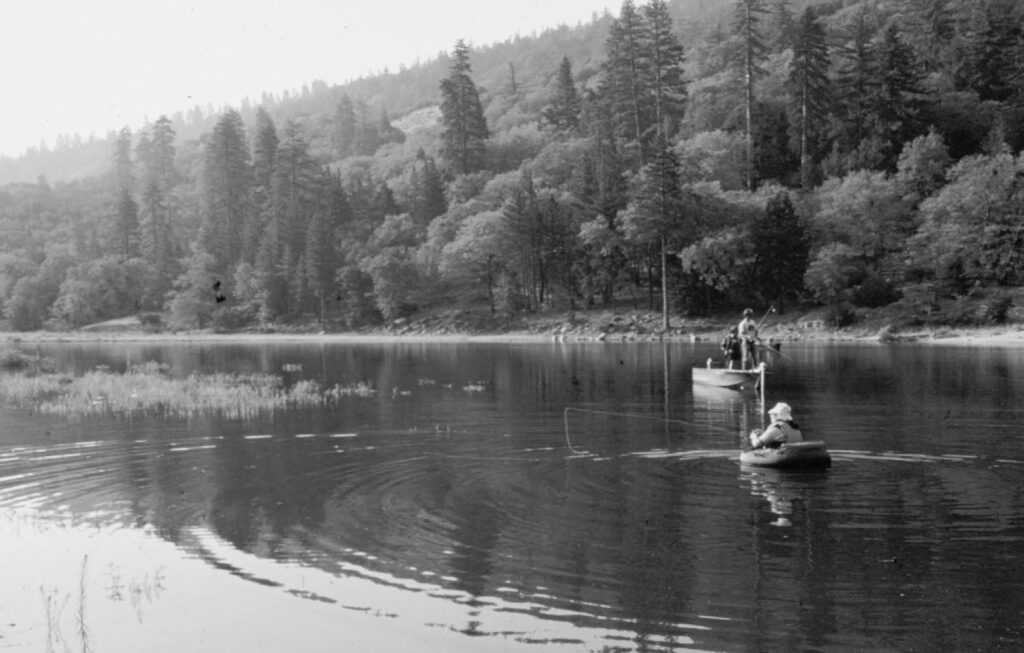
The main entrance to the lake and its marina, campground, and other facilities is off Highway 138, which comes in from Interstate 15 and winds past Silverwood, then heads up to the mountain community of Crestline.
Once you pass through the main gate, you have the choice of heading down to the main marina area, several parking areas, and the launch ramp, or of turning left just past the entrance and driving down into the Cleghorn day-use area, which has a couple of sizeable parking lots right by the water and a secondary launch ramp for small boats.
Most of south shore of the lake is connected by a paved bicycle path that you can bike or walk to reach a lot of good-looking shoreline. While a boat serves as the best way to cover Silverwood Lake, the shore or float-tube angler has multiple choices of areas to fish because of these bike paths and parking areas.
The third entrance to the lake is at the east end and goes into the Miller Canyon arm of the lake. The road used to run for a couple of miles down to a parking area on the north side of Miller Canyon, but it has been closed to motor vehicle access for several years following a fire and landslide that destroyed part of the road. Anglers can still bike or walk into the area, and some of the very best angling can be found there.
One of the interesting aspects of fishing at Silverwood is that while entry into the park is controlled, with regular hours of operation, the lake itself is actually open to fishing 24 hours a day, and if you choose to park just outside the park boundary and walk in, you are free to do so.
One of those “outside” parking spots is on Forest Service Route 2N32. This dirt road runs off the paved road to the dam just before the parking area and heads south around the eastern end of the lake. After a couple of twisting miles of bumpy road, you will find yourself above the Live Oak boat-in beaches, and you can park your vehicle and walk down the slope to fish this area.
Here there are trails that lead around three large coves, and there are permanent toilets and picnic tables out on the point. Be sure to have an Adventure Pass hanging from your rear view mirror, or you’ll get a parking ticket from the Forest Service, because the parking on the dirt road is considered to be inside the San Bernardino National Forest, even if you park on the Silverwood side of the road.
You can also park at several paved turnout parking areas along Highway 173 and walk trails or maintenance access roads down to the lake. One of the author’s favorite day hikes is to park at the maintenance road that goes down to the dam off of Highway 173, then hike down to the water’s edge in the Chamise area of the lake and fish along the shore for a mile or so, finally climbing out on a power line road that leads up to a second parking area and walking down the highway back to where the car is parked.
Silverwood Lake is close to major Southland cities, not far off a major freeway, and has a varied and interesting fishery that can be angled with fly tackle. It’s highly popular as a recreation destination and can be crowded on summer weekends, but it is also a fine place to get away from it all and catch a few fish.
If You Go . . .
Located close enough to most of Southern California to be handy, the Silverwood Lake State Recreation Area is also just far enough away to be in a part of the San Bernardino National Forest overlooking the Mojave Desert. Take Interstate 15 north through Cajon Pass, then exit at Highway 138. Turn right and follow Highway 138 east 11 miles until you reach the entrance to Silverwood Lake State Recreation Area.
Almost anything that floats is legal at Silverwood. Because of ongoing concerns about quagga and zebra mussel infestations, however, watercraft inspections are performed on all craft entering the lake. See the California State Parks website listed below for information.
Silverwood has well-designed launch ramps, one for large boats near the marina on the south shore and a smaller ramp for cartops and such in the Cleghorn area, There’s plenty of parking, except on the busiest of summer weekends. It also has a large boat and trailer parking area at the launch ramp that can accommodate around 300 boats, a campground, and a marina store. For more information, contact Silverwood at (760) 389-2303 or the marina at (760) 389-2299. See also http://www.parks.ca.gov/default.asp?page_id=650. To reserve a campsite, call (1-800) 444 PARK ([1-800] 444-7275). Summer hours are from 6:00 A.M. to 9:00 P.M. for day use. Winter hours, from October to April, are 7:00 A.M. to 7:00 P.M. Boat launching starts when the park opens, and boats may remain on the water until sunset.
There are two fly shops that can outfit you for fishing at Silverwood, but they are not close to the lake. Bob Marriott’s Flyfishing Store is at 2700 West Orangethorpe Avenue in Fullerton; phone (800)-535-6633, on the Web at http://www.bobmarriottsflyfishingstore.com. There is also the fly-fishing department inside the Bass Pro Shop in Rancho Cucamonga, at 7777 Victoria Gardens Lane; phone (909) 9225500. The only guide in the area is Keith Kern in Big Bear City. He guides fly anglers on Big Bear Lake, Silverwood Lake, and local streams in the San Bernardino Mountains. You can contact Keith at (909) 585-3804.
For a good topographical map of the lake, check with Fish-n-Map Company, 8535 West 79th Avenue, Arvada, CO 80005, (303) 421-5994, http://www.fishnmap.com.Their topo map, printed on waterproof stock, includes Silverwood Lake, Lake Skinner, and Lake Perris, all for a price of $6.95.
Silverwood has good access to much of the shoreline, but a boat is the best fishing platform. Silverwood allows the use of boats, float tubes and pontoon boats, and kayaks, and you can wade the shallow areas. If there’s such a thing as an ideal lineweight and rod combination, it’s probably a 6-weight or 7-weight. I’ve fished Silverwood with a 4-weight and a 10-weight, and both are necessary at times, but a middle-of-the-road choice works most of the year. A rod 8 to 9 feet long casting either a 6-weight or 7-weight line will suffice for most angling situations. Sinking lines are used for probably two-thirds to three-quarters of the fishing here.
Silverwood gets very hot in the summer and can be brutally cold in the wind in winter. Appropriate dress can be anything from shorts to a snowmobile suit, depending on the season. The lake does not freeze over in the winter. Night fishing is allowed from the shore.
All boats, personal watercraft, kayaks, canoes, sailboards, inflatables, and float tubes must undergo a mandatory inspection to prevent the spread of quagga and zebra mussels. These invasive species threaten the recreational opportunities of the general public, the water delivery infrastructure of California, and the aquatic habitat of Silverwood Lake. Failure to allow inspection of any watercraft will result in the refusal to launch.
Richard Alden Bean




